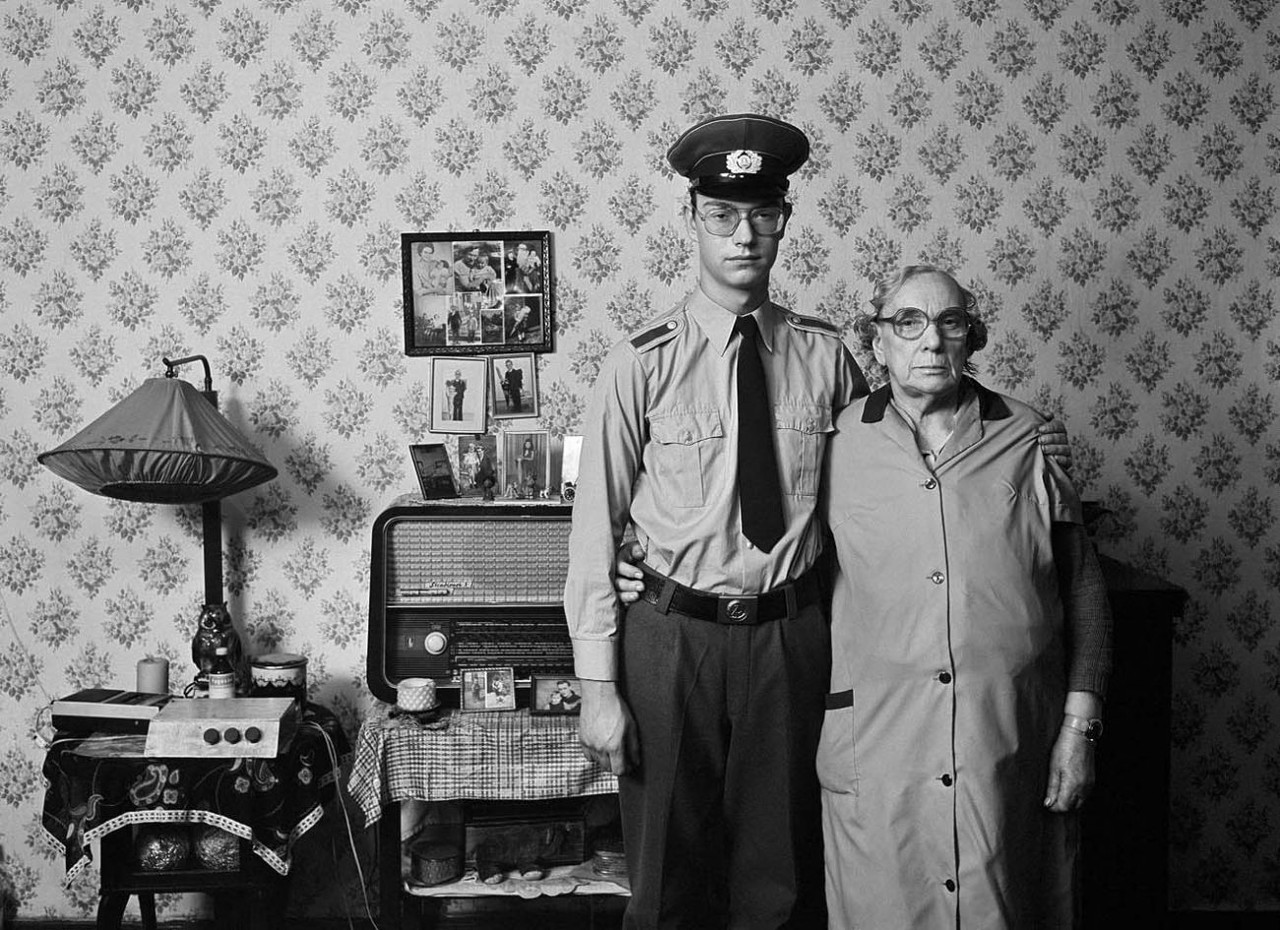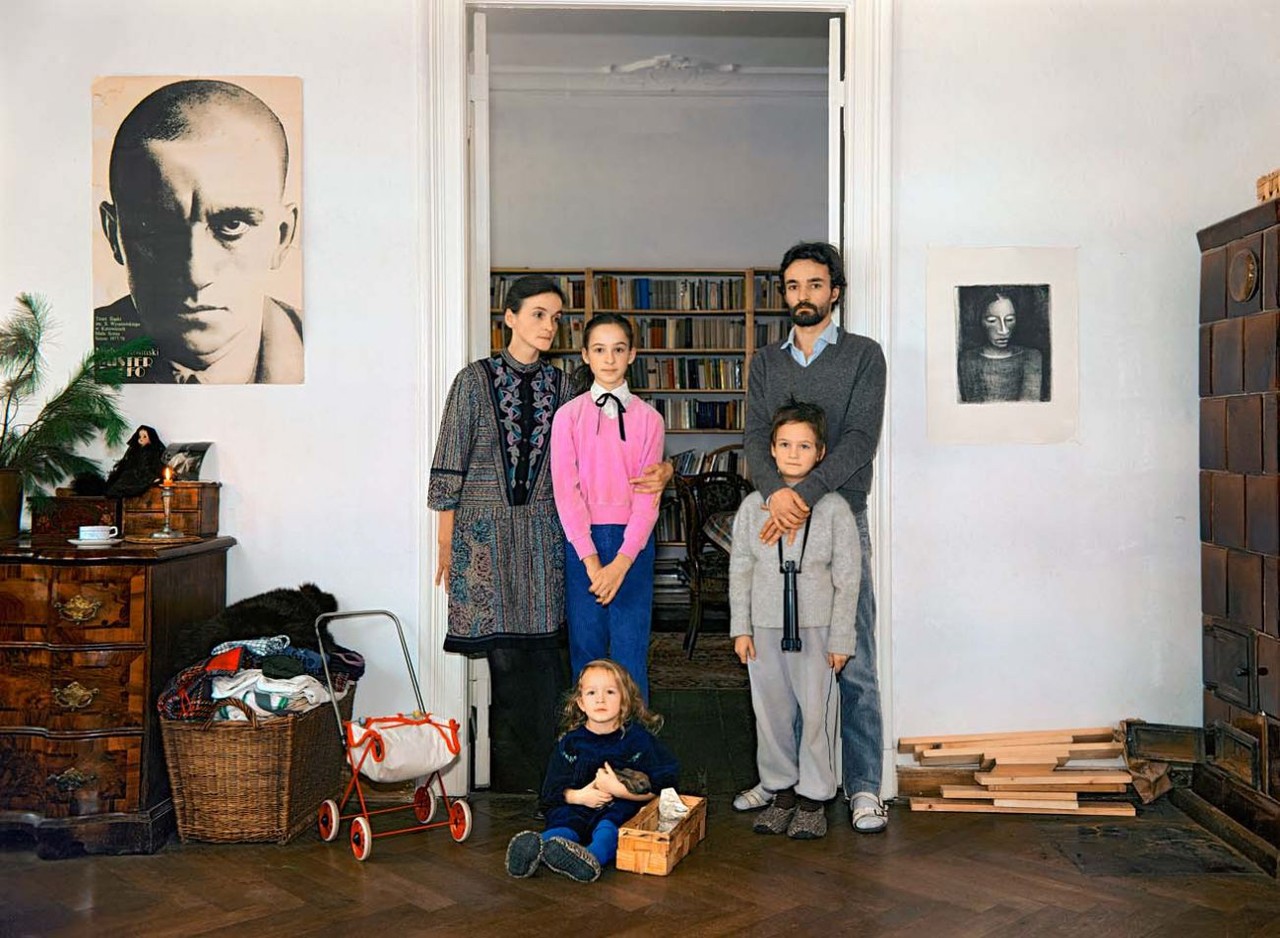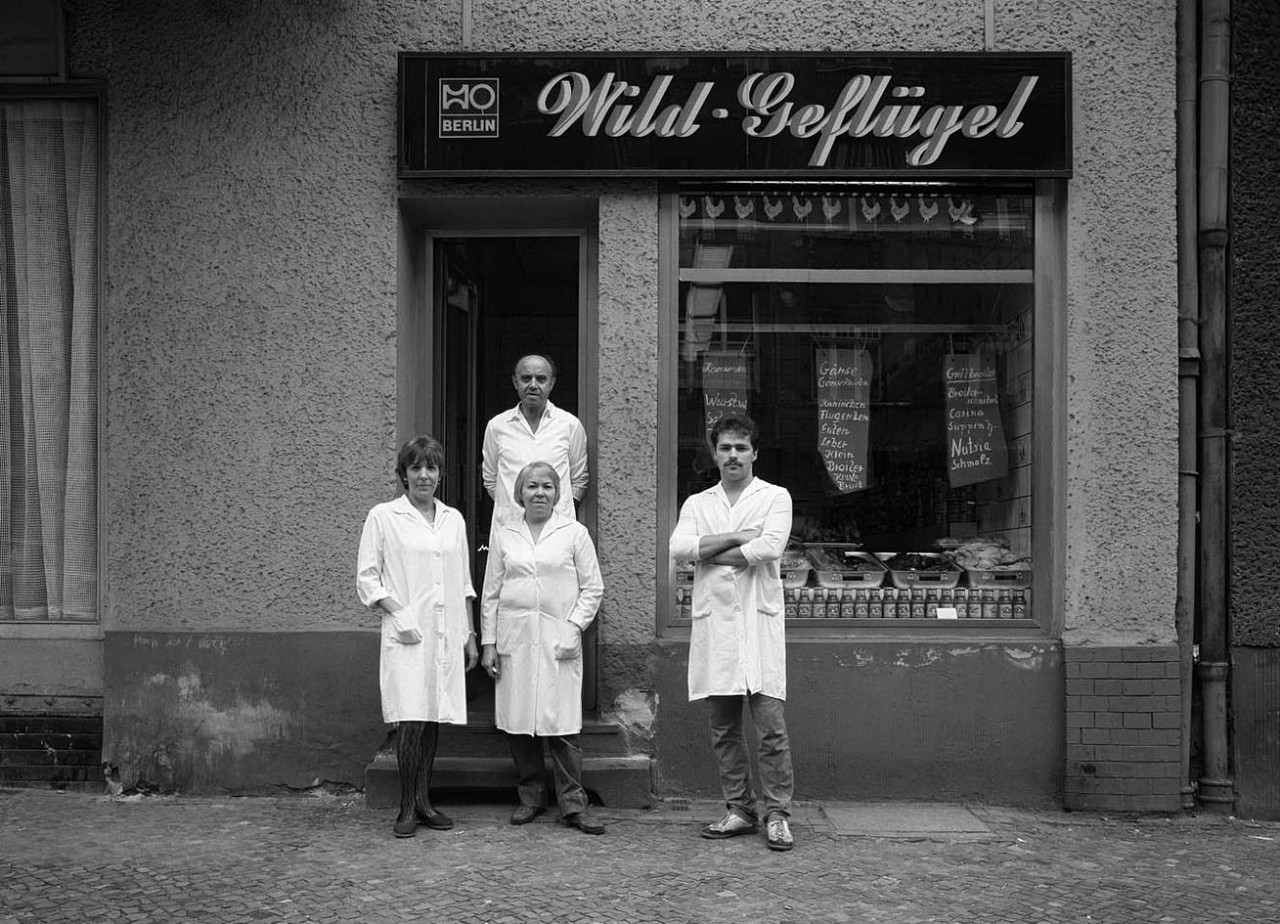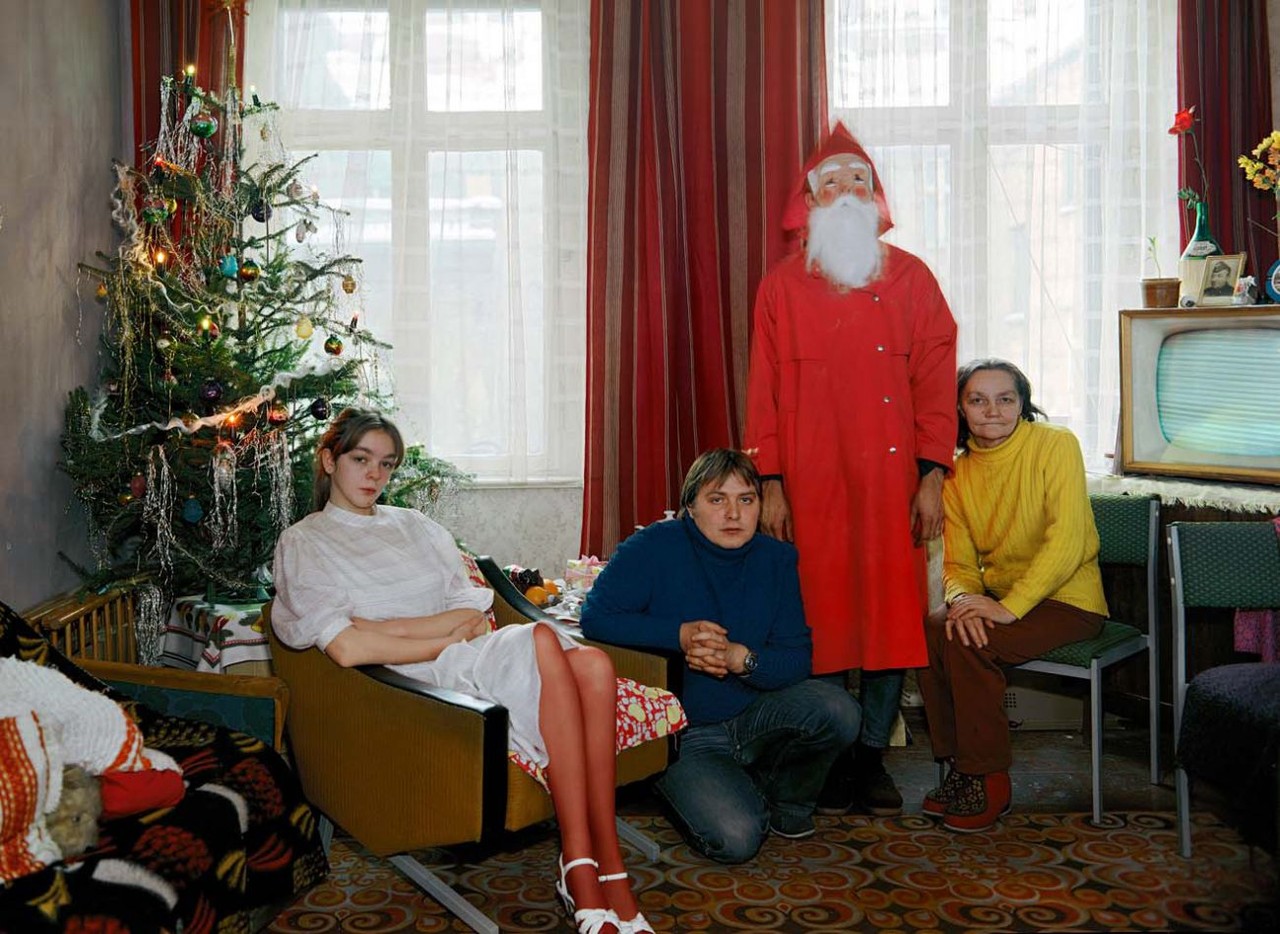Harf Zimmermann
Hufelandstraße . 1055 Berlin
29 Apr - 02 Jul 2017

Das Brautpaar Dreßler hat das Paket „Traditionshochzeit 750 Jahre Berlin“ gebucht, 1987 © Harf Zimmermann
HARF ZIMMERMANN
Hufelandstraße . 1055 Berlin
29 April - 2 July 2017
“The street is more beautiful than I expected, but also more foreign. It lies in the old East – yet that East has eluded it.” Joachim Gauck
Just one kilometer in length, with 49 beautiful and historic houses from the Gründerzeit period and a single modern one from after Reunification, a playground, old cobble-stone streets, superb linden trees and broad sidewalks—Hufelandstraße, planned and built by a brewer, stretches from Greifswalder Straße to Volkspark Friedrichshain through the so-called Bötzowviertel, the neighborhood named after the same brewer. Even then, it was no typical street for Prenzlauer Berg and that’s not only because the photographer Harf Zimmermann made it the subject of his own kind of photo project in the mid-1980s. Over the course of a year, we went from house to house, resident to resident, and store to store to capture the special characteristics of the quarter nestled in postal code NO 55, later changed to 1055. In the middle of the East German capital, he discovered an enclave of bourgeois middle class: spacious pre-war apartments, generously adorned foyers, double doors and parquet as well as small shops and workshops. Zimmermann’s reserved, but in no way passive, documentation of architecture and people is a unique witness to socialism on the eve of its collapse.
The images by Harf Zimmermann evoke memories of coal smoke and bare masonry. On the crumbling facades, bullet holes from the Second World War are still visible. The endless, monotone gray penetrates everything and rules the GDR from north to south. By contrast, the residents offer a far more colorful presence than the architectural conditions of socialism: Craftsmen, artists, musicians, party officials, actors and piano makers. While the SED (Socialist Unity Party of Germany) conjured new city districts in Marzahn and Hellersdorf out of thin air with their housing projects, it seemed unable to cope with the historic house of the Hufelandstraße. They remained a legacy of capitalism. Family-run businesses, which had long been dispossessed in other places, continued to flourish here without spoon-feeding from the public offices or trade organizations. Everyone here seemed to feel connected to the street and responsible for it—constantly striving to maintain this small habitat for as long as possible.
The Hufelandstraße, often called the “Kurfürstendamm of the East” behind closed doors, is not only an example of unedited biographies in the defunct GDR, but from today’s perspective a case study in the rapid gentrification and structural change in the inner-city following 1989 as well. Only a handful of the original residents from the time of Harf Zimmermann’s images continue to live there. Hardly any other neighborhood in East Germany has experienced such a complete and total swap out of its residents over the last 25 years. Almost all buildings have been renovated, the traces of their history painted over, and the rental prices driven sky high.
Harf Zimmermann was inspired by US-American photographer Bruce Davidson for his documentary project, which was also his final project as the master student of Arno Fischer at the Academy of Visual Arts Leipzig. In the 1970s, he spent two years in Spanish Harlem in New York and photographed the life in and around a housing block at East 100th St. Like Davidson, Zimmermann didn’t take snapshots, but in a way more captured the goings-on in photographic format. He used wooden plate cameras of various sizes, which in part were as old as the neighborhood around Hufelandstraße itself. But most of the images were taken with a Linhof camera from the 1930s, format 9x12cm. Work with large-format cameras requires patience and a great deal of staying power and both are very present in Zimmermann’s work. The outdoor shots in the Hufelandstraße were largely done in black and white in order to draw the viewer’s gaze to the essential components. The families in their private homes were shot in color, which accentuates the intimate nature of the images.
In the images of Harf Zimmermann, there resides something static, something final, which further moves the content out of its chronological context. Beyond glorifying nostalgia and retrospective wishfulness, this work is a unique sociocultural document of the Berlin of the 1980s, a city in the throes of rapid change. The exhibition with around 95 images is being shown for the first time at C/O Berlin and complements the historic analysis of the DDR with an important aspect of the history of everyday life. It was curated by Felix Hoffmann. A publication from the Steidl Verlag with an essay from Joachim Gauck will accompany the publication.
Harf Zimmermann, born in Dresden in 1955, studied Journalism at the University of Leipzig (formally Karl Marx University) until 1979 and later worked as a photo lab technician at “Neuen Deutschland”. From 1982 until 1987, he studied photography under Professor Arno Fischer at the Academy of Visual Arts Leipzig and has since worked as a freelance photographer and photo designer. In 1990, Harf Zimmermann counted among the founding members of the photo agency OSTKREUZ, which he belonged to for ten years. He published his photographs in numerous national and international newspapers and magazines—including Stern, GEO, Merian, DIE ZEIT, The New York Times Magazine, The New Yorker, TIME. Harf Zimmermann lives and works in Berlin.
Hufelandstraße . 1055 Berlin
29 April - 2 July 2017
“The street is more beautiful than I expected, but also more foreign. It lies in the old East – yet that East has eluded it.” Joachim Gauck
Just one kilometer in length, with 49 beautiful and historic houses from the Gründerzeit period and a single modern one from after Reunification, a playground, old cobble-stone streets, superb linden trees and broad sidewalks—Hufelandstraße, planned and built by a brewer, stretches from Greifswalder Straße to Volkspark Friedrichshain through the so-called Bötzowviertel, the neighborhood named after the same brewer. Even then, it was no typical street for Prenzlauer Berg and that’s not only because the photographer Harf Zimmermann made it the subject of his own kind of photo project in the mid-1980s. Over the course of a year, we went from house to house, resident to resident, and store to store to capture the special characteristics of the quarter nestled in postal code NO 55, later changed to 1055. In the middle of the East German capital, he discovered an enclave of bourgeois middle class: spacious pre-war apartments, generously adorned foyers, double doors and parquet as well as small shops and workshops. Zimmermann’s reserved, but in no way passive, documentation of architecture and people is a unique witness to socialism on the eve of its collapse.
The images by Harf Zimmermann evoke memories of coal smoke and bare masonry. On the crumbling facades, bullet holes from the Second World War are still visible. The endless, monotone gray penetrates everything and rules the GDR from north to south. By contrast, the residents offer a far more colorful presence than the architectural conditions of socialism: Craftsmen, artists, musicians, party officials, actors and piano makers. While the SED (Socialist Unity Party of Germany) conjured new city districts in Marzahn and Hellersdorf out of thin air with their housing projects, it seemed unable to cope with the historic house of the Hufelandstraße. They remained a legacy of capitalism. Family-run businesses, which had long been dispossessed in other places, continued to flourish here without spoon-feeding from the public offices or trade organizations. Everyone here seemed to feel connected to the street and responsible for it—constantly striving to maintain this small habitat for as long as possible.
The Hufelandstraße, often called the “Kurfürstendamm of the East” behind closed doors, is not only an example of unedited biographies in the defunct GDR, but from today’s perspective a case study in the rapid gentrification and structural change in the inner-city following 1989 as well. Only a handful of the original residents from the time of Harf Zimmermann’s images continue to live there. Hardly any other neighborhood in East Germany has experienced such a complete and total swap out of its residents over the last 25 years. Almost all buildings have been renovated, the traces of their history painted over, and the rental prices driven sky high.
Harf Zimmermann was inspired by US-American photographer Bruce Davidson for his documentary project, which was also his final project as the master student of Arno Fischer at the Academy of Visual Arts Leipzig. In the 1970s, he spent two years in Spanish Harlem in New York and photographed the life in and around a housing block at East 100th St. Like Davidson, Zimmermann didn’t take snapshots, but in a way more captured the goings-on in photographic format. He used wooden plate cameras of various sizes, which in part were as old as the neighborhood around Hufelandstraße itself. But most of the images were taken with a Linhof camera from the 1930s, format 9x12cm. Work with large-format cameras requires patience and a great deal of staying power and both are very present in Zimmermann’s work. The outdoor shots in the Hufelandstraße were largely done in black and white in order to draw the viewer’s gaze to the essential components. The families in their private homes were shot in color, which accentuates the intimate nature of the images.
In the images of Harf Zimmermann, there resides something static, something final, which further moves the content out of its chronological context. Beyond glorifying nostalgia and retrospective wishfulness, this work is a unique sociocultural document of the Berlin of the 1980s, a city in the throes of rapid change. The exhibition with around 95 images is being shown for the first time at C/O Berlin and complements the historic analysis of the DDR with an important aspect of the history of everyday life. It was curated by Felix Hoffmann. A publication from the Steidl Verlag with an essay from Joachim Gauck will accompany the publication.
Harf Zimmermann, born in Dresden in 1955, studied Journalism at the University of Leipzig (formally Karl Marx University) until 1979 and later worked as a photo lab technician at “Neuen Deutschland”. From 1982 until 1987, he studied photography under Professor Arno Fischer at the Academy of Visual Arts Leipzig and has since worked as a freelance photographer and photo designer. In 1990, Harf Zimmermann counted among the founding members of the photo agency OSTKREUZ, which he belonged to for ten years. He published his photographs in numerous national and international newspapers and magazines—including Stern, GEO, Merian, DIE ZEIT, The New York Times Magazine, The New Yorker, TIME. Harf Zimmermann lives and works in Berlin.




